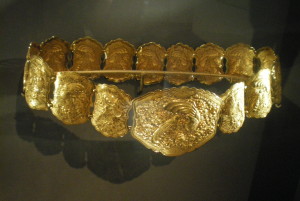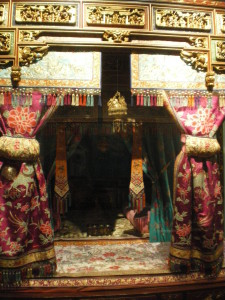The Culture
The Peranakan museum’s galleries span three floors: the first floor gallery describes the Origins of the Peranakan culture; the second floor focuses on Peranakan weddings; and the third floor explores language and fashion, religion, public life and food and feasting.
Gallery 1, Origins
I particularly liked the Origins gallery. Large portraits of Peranakans of all ages were displayed along the walls, with a short quote from each of them about what it meant to be Peranakan. Every single person was smiling, proud to be sharing their thoughts on their culture; it was a truly uplifting beginning to the journey around the museum. Generally people felt their Peranakan identity expressed itself in food, language and looks, but many Peranakans also expressed a shared sense of identity with other cultures, such as Singaporean and Indian cultures, and seemed to feel it was a privilege to belong to both worlds.
A short video explains that the Peranakan culture had its origins in trading along the Silk Road. Foreign traders settled in port cities in the 15th and 16th centuries, marrying local women and bringing up children who adopted a rich blend of cultural traditions.
Galleries 2-5, Weddings
The Wedding galleries displayed some of the exquisite objects used in Peranakan wedding ceremonies. Traditionally, weddings lasted twelve days.
Brides would wear spectacular wedding jewellery, such as this headdress and belt. Less wealthy families would rent wedding jewellery from wealthier families.
The marital bed. This was associated with rituals such as having a young male relative roll across the bed to spread male energy, which was thought to promote fertility and increase the chances of the first child being a boy. In another ritual, the groom’s female relatives having the right to inspect a handkerchief that had been spread across the bed on the twelfth day of the wedding, when the marriage was consummated. The groom’s family had the right to reject the bride if they were not satisfied. If the bride was accepted, everyone ate coconut rice!
Gallery 6, Language and Fashion
A clever interactive exhibit on Peranakan language – lifting the receiver allowed you to hear a recording of a conversation.
Gallery 7, Religion
Peranakan religion embraces a mixture of beliefs such as Taoism, Buddhism and ancestor worship.
Gallery 9, Food and Feasting
Food is a central part of Peranakan culture. It includes Chinese, Thai, Malay, Indonesian and European elements. Cook books are available in the museum shop and Singapore’s Peranakan restaurant, Blue Ginger, also allows for the opportunity to try Peranakan food.
The gallery included a reconstruction of a pre-second world war kitchen. The kitchen was an important space, where children were looked after, chores such as ironing were done and meals were prepared. It was therefore a female domain, where women entertained close female friends and relatives. The kitchen hosts a “special video” every hour, but unfortunately I did not visit at the right time to see it.
The Coffee
The Peranakan Museum’s shop houses a small café, True Blue Pantry, where visitors are served refreshments by a gentleman in traditional Peranakan costume. I opted for the floral set for SG$5+, which included rose or jasmine tea and floral biscuits. I am a big fan of tea with rosebuds, so I chose rose tea. A posh teabag with rosebuds inside was used to brew the tea in the mug. The flavour could have been stronger – even after a good few minutes’ brewing it still tasted a little watery, but it was certainly a pleasantly floral, refreshing drink. The biscuits turned out to be rich and buttery, a pleasant surprise in a country that is not always comfortable with dairy products.
The Company
I visited the museum and café alone. My company in the café was Miranda Dickinson’s It Started with a Kiss, a book featuring blogging as part of the plot, which may have subconsciously influenced me when the idea for this blog came to me (some other great books featuring blogging: Leftovers by Stella Newman and I Heart New York by Lindsey Kelk).
Visitor’s View
The Peranakan Museum’s layout works very well, with the introductory gallery on the first floor, the Weddings galleries on the second floor and further details around Peranakan culture on the third floor. The complex set of rituals around Peranakan weddings is fascinating. The galleries on the second floor did a great job of unfolding the story of different traditions on different days of the twelve day wedding ceremony, combining beautiful objects with focused text.
The Modern Wedding video, in Gallery 2, Weddings, gave an interesting insight into how Peranakan traditions have translated into life today. The video consisted of a few different couples speaking about their experiences of being together and how Peranakan culture and traditions influenced them. One couple explained that their parents expected them to keep some traditional Peranakan elements in their wedding ceremony, for example the rolling of the young male relative on the bed. Peranakans seemed to be adapting their traditions while maintaining their unique identity.
The Peranakan Museum, 39 Armenian Street, Singapore 179941, visited on 10 November 2013. Admission is free for Singaporean citizens and permanent residents, SG$6 for non-Singaporean/ non-PR adults. A SG$10 ticket granting admission to the Peranakan Museum, the Singapore Art Museum and the Singapore National Museum, valid for one visit to each, to be used before 16 February, is available until 16 February.




